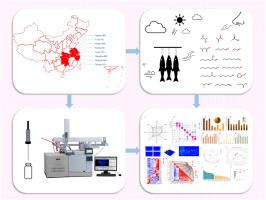通过GC×GC-TOFMS解码不同地区草鱼干的香气活性化合物和感官影响
IF 6.6
1区 农林科学
Q1 FOOD SCIENCE & TECHNOLOGY
引用次数: 0
摘要
草鱼干是我国传统食品,使用历史悠久,具有很高的经济价值。其风味已成为食品品质提升研究的一个重要方面。本研究选取了来自不同地区的8种晒干草鱼。定量描述性分析显示,从武汉收集的样本可能因其最高的草/新鲜和最低的鱼/臭气味而受到感官小组的青睐。随后,采用顶空固相微萃取结合综合二维气相色谱-飞行时间质谱(GC × GC - tofms)检测了467种芳香化合物。根据其气味活性值筛选出45个对香气贡献较大的化合物。最终的统计模型进一步确定了不同地区的18种不同的香气化合物。结果表明,乙酰酮和2,3-丁二酮浓度越高,总体偏好得分越高,而1-辛烯-3-醇和醛浓度越高,感官得分越低。这些发现对提高草鱼及其加工产品的产量具有指导意义。本文章由计算机程序翻译,如有差异,请以英文原文为准。

Decoding the aroma-active compounds and sensory impact of dried grass carp (Ctenopharyngodon idella) from different regions through GC×GC–TOFMS
Dried grass carp is a traditional Chinese food product with a long history of use and high economic value. Its flavor has become a crucial aspect in quality enhancement research. In this study, eight types of sun-dried grass carp from different regions were selected. Quantitative descriptive analysis revealed that samples collected from Wuhan were likely favored by the sensory panel for their highest grass/fresh and lowest fishy/stinky notes. Subsequently, 467 aroma compounds were detected using headspace solid-phase microextraction in conjunction with comprehensive two-dimensional gas chromatography–time-of-flight mass spectrometry (GC × GC–TOFMS). Among them, 45 compounds with higher contributions to aroma were selected based on their odor activity values. The final statistical model further identified 18 different aroma compounds among the different regions. Results indicated that higher concentrations of acetoin and 2,3-butanedione are correlated with higher overall preference scores, while higher concentrations of 1-octen-3-ol and aldehydes are associated with lower sensory scores. These findings provided guidance for improving the production of grass carp and its processed products.
求助全文
通过发布文献求助,成功后即可免费获取论文全文。
去求助
来源期刊

LWT - Food Science and Technology
工程技术-食品科技
CiteScore
11.80
自引率
6.70%
发文量
1724
审稿时长
65 days
期刊介绍:
LWT - Food Science and Technology is an international journal that publishes innovative papers in the fields of food chemistry, biochemistry, microbiology, technology and nutrition. The work described should be innovative either in the approach or in the methods used. The significance of the results either for the science community or for the food industry must also be specified. Contributions written in English are welcomed in the form of review articles, short reviews, research papers, and research notes. Papers featuring animal trials and cell cultures are outside the scope of the journal and will not be considered for publication.
 求助内容:
求助内容: 应助结果提醒方式:
应助结果提醒方式:


